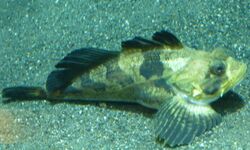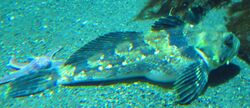Biology:Yellow Irish lord
| Yellow Irish lord | |
|---|---|

| |
| At Alaska SeaLife Center, Seward, Alaska | |
| Scientific classification | |
| Domain: | Eukaryota |
| Kingdom: | Animalia |
| Phylum: | Chordata |
| Class: | Actinopterygii |
| Order: | Scorpaeniformes |
| Family: | Agonidae |
| Genus: | Hemilepidotus |
| Species: | H. jordani
|
| Binomial name | |
| Hemilepidotus jordani Bean, 1881
| |
The yellow Irish lord (Hemilepidotus jordani) is a species of marine ray-finned fish belonging to the family Agonidae It is found in the northern Pacific Ocean.
Taxonomy
The yellow Irish lord was first formally described in 1881 by the American ichthyologist Tarleton Hoffman Bean with its type locality given as Ilyulyuk Unalaska Island in the Aleutian Islands of Alaska.[1] Bean did not identify the identity of the person honored in the specific name but it is most likely to be David Starr Jordan.[2]
Description

The mature animal is 34–38 cm (13–15 in) in length. Dorsal coloration consists of alternating black and yellow stripes with small white spots laterally. The ventral surface is cream-colored. The fish has 11–12 dorsal spines, 18–23 dorsal soft rays and 35 vertebrae. This species has a maximum published total length of 65 cm (26 in).[3] There is an incision in the first dorsal fin. There are thin cirri on the upper lip.[4]
Distribution and habitat
Hemilepidotus jordani lives in benthopelagic marine environments of the northern Pacific Ocean, between 66°N–54°N, and 154°E–134°W. This corresponds to the northern Kuril Islands and Kamchatka Peninsula to the Gulf of Anadyr and Sitka, Alaska. This bathydemersal fish is found at depths between 257 and 604 m (843 and 1,982 ft).[3]
Biology
The yellow Irish lord has a largely unknown biology. Examination of ovaries of female specimens suggest that these fish spawn once annually during the summer. They are predatory fishes which feed on a wide variety of prey, predominantly crabs, although the largest adults eat other fishes.[5] They live to a reported maximum age of 30 years.[3]
References
- ↑ Eschmeyer, William N.; Fricke, Ron; van der Laan, Richard, eds. "Species in the genus Hemilepidotus". California Academy of Sciences. http://researcharchive.calacademy.org/research/ichthyology/catalog/fishcatget.asp?tbl=species&genus=Hemilepidotus.
- ↑ Christopher Scharpf; Kenneth J. Lazara, eds (11 July 2021). "Order Perciformes: Suborder Cottoidea: Infraorder Cottales: Families Trichodontidae, Jordaniidae, Rhamphocottidae, Scorpaenichthyidae and Agonidae". The ETYFish Project Fish Name Etymology Database. Christopher Scharpf and Kenneth J. Lazara. https://etyfish.org/perciformes19/.
- ↑ 3.0 3.1 3.2 Froese, Rainer and Pauly, Daniel, eds. (2008). "Hemilepidotus jordani" in FishBase. December 2008 version.
- ↑ "Common SCULPIN of Cook Inlet". Alaska Department of Fish and Game. https://accs.uaa.alaska.edu/wp-content/uploads/commonsculpincookinlet.pdf.
- ↑ Todd T. TenBrink; Troy W. Buckley (2013). "Life-History Apects of the Yellow Irish Lord (Hemilepidotus jordani) in the eastern Bering Sea and Aleutian Islands". Northwestern Naturalist 94 (2): 126-136.
- "Hemilepidotus jordani (Bean, 1881)". Integrated Taxonomic Information System. https://www.itis.gov/servlet/SingleRpt/SingleRpt?search_topic=TSN&search_value=167280.
Wikidata ☰ Q1998986 entry
 |

